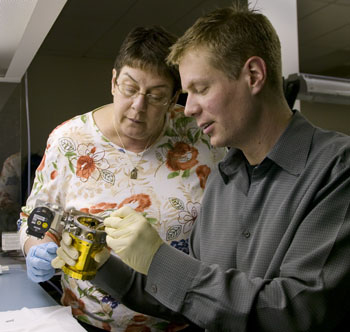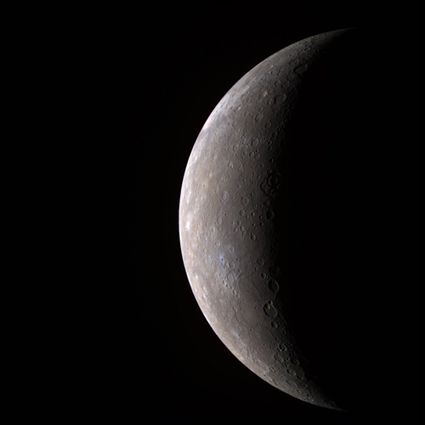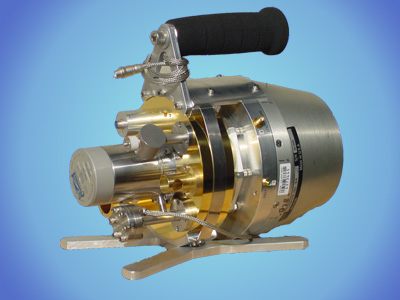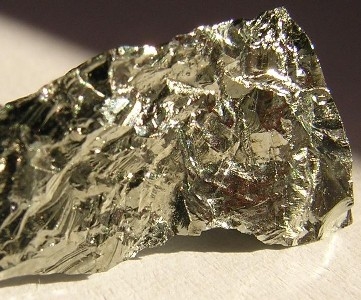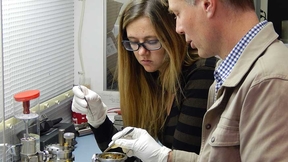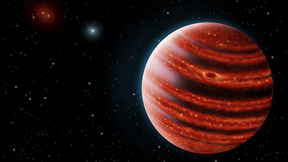MESSENGER carries technology germane to homeland security
Call it serendipity. Call it ingenuity.
But when researchers from the Laboratory and Lawrence Berkeley were tasked with building a gamma ray spectrometer for NASA’s Mercury MESSENGER, they didn’t necessarily know that they could turn to an existing homeland security instrument to help them out.
But that’s exactly what happened.
In 2001, LLNL teamed with LBNL to design a germanium-based gamma ray spectrometer (GRS) instrument to be installed on the NASA Mercury MESSENGER (short for MEcury Surface, Space Environment, GEchemistry and Ranging) spacecraft, where the apparatus will be used to help identify the mineral make-up of the surface composition.
The trick was to build an instrument that could withstand the extreme heat radiating from Mercury’s surface. Because the planet is so close to the sun and has an energy output equivalent to 11 suns as seen from the Earth, Mercury can reach as high as 400 degrees Celsius (752 degrees Fahrenheit). In order for the germanium-based spectrometer to operate correctly, the crystal has to be cooled to -200 degrees Celsius.
How do you do that with the extreme temperatures on and near Mercury?
That’s where Livermore researchers come in. The initial thought was that it would be impossible to operate a cryogenically-cooled instrument near Mercury. But with a little creativity, the team of researchers came up with a thermal and mechanical cooling design that allows the germanium crystal to live at -200 degrees Celsius while rejecting 98 percent of the infrared heat and energy from the broiling surroundings.
To date, only NASA’s Mariner 10 spacecraft has traveled to Mercury. The spaceship performed three flybys in 1974-75 and returned the very first images of Mercury to Earth. However, only 45 percent of the surface was photographed and the spacecraft contained no X-ray or gamma-ray spectrometers.
MESSENGER, which was launched in 2004, will completely orbit Mercury with X-ray, gamma-ray, infrared and EUV, neutron and charged particle spectrometers. To orbit Mercury, MESSENGER must follow a path through the inner solar system, including one flyby of Earth, two flybys of Venus and three flybys of Mercury. The journey will return the first new spacecraft data from Mercury since the Mariner 10 mission more than 30 years ago.
Mercury, Venus, Earth, and Mars are terrestrial (rocky) planets. Mercury is an extreme: the smallest, the densest (after correcting for self-compression), the one with the oldest surface, the one with the largest daily variations in surface temperature and the least explored.
Livermore’s spectrometer will help answer some of the questions surrounding the mysterious planet including why Mercury is so dense; the geological history; the structure of Mercury’s core and magnetic field; what volatiles are important to Mercury; and the detection of radar reflective material at the poles.
The GRS instrument took its first data from Mercury on Jan. 14 during the first flyby and worked flawlessly.
"You’re a little nervous because it has been flying in deep space since 2004, exposed to cosmic radiation and extreme thermal fluctuations," said Morgan Burks, formerly at LBNL and now working in the Lab’s Physical Sciences Directorate. "Although it was tested quite rigorously before launch, it was still a relief to see it turned on and perform beautifully at Mercury."
Fast forward to today. The same gamma ray instrumentation used in MESSENGER, is now being tested for homeland security in the form of a small radiation detector.
"We’ve taken the MESSENGER technology and used it to create the next generation hand-held gamma-ray detector," Burks said.
The MESSENGER detector is a spinoff of the Lab’s Cryo-3 , a mobile, handheld mechanically cooled germanium radiation detector that can detect gamma rays from radioactive material. But the new radiation detector, called GeMini, is lighter, smaller and more energy efficient than Cryo 3. Using lithium polymer batteries, the new detector can run for 10 hours at a time whereas Cyro 3 could only operate on a 2-3 hour range.
Burks said the detector could be used in ports or airports or anywhere else that inspectors need to check for radioactive materials.
And what makes the instrument better than other radiation detectors is the germanium. Germanium radiation detectors provide a higher resolution of the material, allowing inspectors to positively identify the substance. For example, if there is a medical isotope (a small quantity of radioactive substance used in safe, cost-effective imaging and treatment of disease) on board an airplane, inspectors could distinguish the material from something more dangerous like the radioactive materials used in a dirty bomb.
"Unlike a Geiger counter, which only tells you that radioactive material is present, a germanium spectrometer will indentify it," Burks said. "The readings are like a fingerprint for the material. Germanium detectors have been around for decades for use in the lab. But this instrument is so small you can carry it around. It could be used for surprise inspections."
The plan is to commercialize the device in 2009.
So in the meantime, Livermore researchers are focusing on the MESSENGER mission and waiting for their device to bring back even more fascinating information about Mercury’s composition including a better understanding of the planet’s magnetic field.
"Our security application led to a space instrument which turned around and will again help in homeland security," Burks said.
Other Livermore researchers who contributed to the MESSENGER work are Monika Witte (LLNL lead), Wayne Miller, Lisle Hagler, Wayne Jensen, Steve DeTeresa, Del Eckels, Mike Gerhard, Wilthea Hibbard, Marty Roeben, Gordon Spellman, John Becker, Peter Meyer, Bob Sanchez and former LBNL scientists (now at LLNL) Norm Madden (LBNL lead) and Chris Cork.


